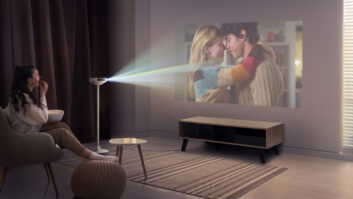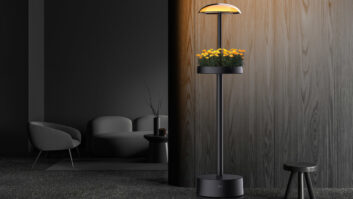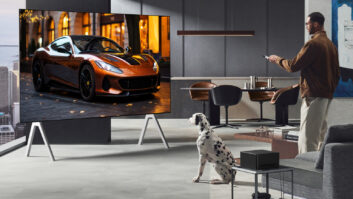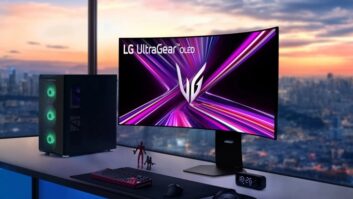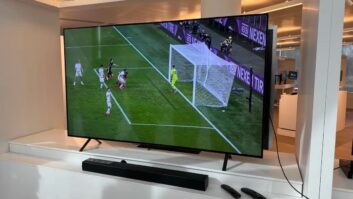ENGLEWOOD, CLIFFS, N.J. —
LG Electronics released
findings from a recent consumer study that
showed 80 percent of consumers prefer the 3DTV experience
wearing passive glasses over more established,
and more expensive, active-shutter 3DTV glasses.
LG launched an ad campaign with an in-your-face tagline
based on the study — “Hey/Sony & Samsung/better
stick to 2D” — the day after the report was released.
The ads broke last Thursday in the Wall Street Journal,
USA Today and on its Times Square billboard, but
no details were released about the size of the budget in
the U.S. or other media buys. The tactic is called “noise
marketing” in Korea, and Korea JoongAng Daily added
in a report last Thursday that since the beginning of the
year, LG and Samsung have been engaged in a war of
words about 3D in their home country.
The study was conducted for LG by market research
firm Morpace last May, measuring an LG Cinema 3D
HD LCD TV head-to-head against active-shutterglasses
based LCD TVs from Sony and Samsung.
Spokesmen for Sony did not return requests for
comment, but Samsung visual display marketing senior
VP John Revie, told TWICE, “We still believe active [shutter technology] is the best solution for consumers,
as it’s the only 3D in-home solution to provide
FullHD, and with our particular execution, you have wider
viewing angles than passive, at 178 degrees both horizontally
and vertically.”
In addition, Samsung cited NPD Group sell-through
numbers showing Samsung with more than 60 percent
market share year to date for total 3DTV sales over the last
12 weeks and with more than 50 percent market share
year to date.
“Consumers all over the country are voting with their
dollars, and they’re voting for active and they’re voting for
Samsung,” said Revie, adding that according to NPD sellthrough
numbers from last month, more than 90 percent of
industry 3DTV sales were active-shutter models.
The brands and models were selected by LG for the
study. No plasma sets or other passive-glasses TV brands
were measured.
LG said the study was designed to measure “consumer
preferences between 3D technology which uses
active-flicker [LG’s term for active-shutter] glasses that
sync with an emitter on the TV and passive technology
that uses polarized glasses similar to those used in movie
theaters.”
LG continues to market 3D plasma TVs using activeshutter
glasses, but decided after International CES to
drop plans to introduce a range of active-shutter-based
3D LCD TVs to focus exclusively on its new Film Patterned
Retarded passive-glasses technology.
LG said the survey “measured real-time feedback from
consumers and shows that LG’s Cinema 3D passive technology
is preferred by consumers across all measured
categories, including overall 3D experience, 3D picture
quality, 3D effect and 3D glasses.”
More than three-quarters of the respondents preferred LG
Cinema 3D for the immersive 3D experience (78 percent),
3D effect (77 percent), overall picture quality (77 percent)
and 3D glasses (78 percent), the Morpace study said.
In the live controlled test, respondents saw a total of
four 3DTVs that displayed the same content and were
asked to rate their experience with each.
The TVs, questionnaire and glasses were all meticulously
de-branded to ensure that brand perceptions had
no impact on consumer preference.
Full survey results and methodology are available at
.
The study was conducted in May and included an LG
TV model 47LW5600 and model AG-F200 passive glasses,
Samsung TV model UN46D6420 with model SSG-
3100GB glasses, and Sony TV model KDL-46EX723
with model TDGBR100/B glasses.
LG Electronics manufactures most of the passive-glasses-
based 3D LCD panels used by both itself and competitive
brands. It opted to omit other passive 3DTV brands
because the study was designed to gauge passive vs.
active-shutter based technologies, said Jay Vandenbree,
LG Electronics USA home entertainment sales and marketing
senior VP.
“Consumers now are more educated than they’ve ever
been. They have a lot more to say about the kinds of purchases
they make than ever before, and we know that on
a level playing field our product sells very well, and if our
retailers put our product next to the competitors’ products,
no doubt they will make the same kinds of choices,”
Vandenbree told TWICE.
Asked if he advocates retailers placing passive and
active-shutter TVs side by side on retail floors vs. separating
them by technology class, he said: “I don’t think it’s a
technology conversation at all. I think it’s a 3D conversation,
and it’s about consumer preference.”
LG said in its system, individual left- and right-eye images
are combined in viewers’ brains to produce 3D pictures
appearing to have FullHD 1080p resolution, although critics
claim the technology halves the resolution to each eye.
In contrast, some proponents of active-shutter TV technology
said their systems present full 1080p images.




